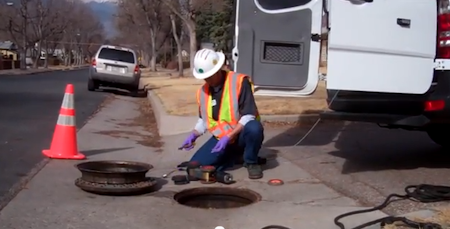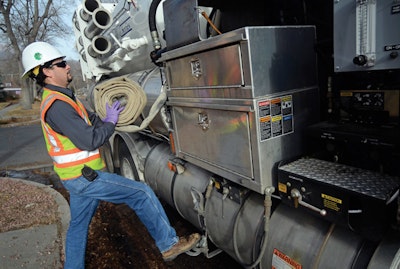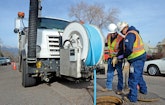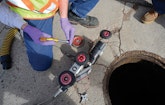
Interested in Inspection?
Get Inspection articles, news and videos right in your inbox! Sign up now.
Inspection + Get AlertsNew to wastewater but not to infrastructure, Dan Fields saw a unique opportunity when he joined Colorado Springs Utilities in 2009.
He sought to improve operations by looking at routine maintenance tasks and methods with a fresh pair of eyes and a new perspective. The results include new methods and practices for cleaning, root control, maintenance scheduling and inspection that are delivering significant and consistent reduction of sanitary sewer overflows (SSOs).
Fields, superintendent of Wastewater Collections and Maintenance, knew he had his work cut out when he transferred to the department after a long and successful career on the potable water side.
Availing himself of multiple information resources, he was a quick study and soon saw a number of areas where a different approach could help the department achieve its cleaning and maintenance objectives in less time and at less cost.
Knowing where you stand
During his daily commute, he noticed something he could apply to the way the department dealt with pipe cleaning. “When you leave your home, wherever you live, by the time you get to work, you know that stretch of road,” he says. “You know what stretch needs to get repaved, where there’s a pothole that you need to avoid, and what sections could go a couple more years before needing to be repaved.
“You see it, and it’s logged into your mind. So I thought that same analogy could work in our sewer system. It was an ‘Aha!’ moment. Everything we do should hinge upon visual, concrete knowledge of the system, not on making assumptions or just cleaning because we think we need to clean it.”
The Colorado Springs collection system includes more than 1,600 miles of gravity-based sewer with 19 lift stations. It is broken down into basins and sub-basins. Cleaning was typically scheduled on a rotating basis: Crews worked in a particular basin, cleaning it from top to bottom, using a variety of methods and tools.
The utility has six CCTV inspection vans equipped with Pathfinder cameras and Badger wheeled transporters (Aries Industries) for assessment of the system. Fields approached management and his teams with the idea of reassigning two of the CCTV vans and crews to inspect pipes before cleaning and to be the “eyes in the pipe.”
These inspection vans formed the basis for a new Basin Recon program. Instead of cleaning the basin completely just from past practice, crews would first inspect each line to determine its cleaning needs.
Recon inspections differ from typical assessments, which require inspection at a specific pace using NASSCO Pipeline Assessment and Certification Program (PACP) defect coding. A Basin Recon assessment is a quick visual pass to determine what cleaning method or tools each segment of line will need — if it needs cleaning at all.
One basin, which contained 4,000 feet scheduled for routine cleaning, was put into the Recon program as a test. Inspections showed that only 1,800 feet actually needed cleaning. “Your biggest expenses for your fleet are fuel and water usage,” says Fields. “By cutting the cleaning workload by more than half — do the math. That adds up to a significant savings.”
The annual cost savings are significant, but the real benefit is the time crews save by going through the basins faster, again reducing the chances of future SSOs, notes Fields. Based on the findings of the test inspections, all basins are now reconnaissance-inspected before maintenance cleaning.
Brains vs. brawn
The department now applies the same look-first approach to emergency response cleaning when applicable. In the past, when crews suspected blockages were caused by the typical culprits of root intrusion or FOG, they deployed heavy-duty cleaning methods.
Case in point: The piping in Colorado Springs is 68 years old on average, half of it vitrified clay pipe (VCP). During a standard CCTV inspection survey in 2007, crews noted a fracture on one segment that was scheduled to be cleaned.
In 2008, when reinspected, that same section showed portions of pipe missing, and no one had accessed the pipe but utility cleaning crews. “One of the benefits of using our CCTV inspection data was learning that in some cases we were our own worst enemy,” says Fields. “In a case like this, we were using overly aggressive methods on a fairly fragile part of the system that, if handled differently, would have remained in serviceable condition for a long time.
“We were defeating the purpose of cleaning, using sheer force and creating damage to our system. It was kind of like using a 12-gauge shotgun to eliminate a pesky fly on the wall. You get rid of the fly, but now you have an expensive repair job to put your wall back in place.
“Now, instead of instantly reaching for the tough mechanical tools, we see the condition of our line segments first. That gives us the opportunity to stop, think and select the right mechanical tool or method that will do the job but create no harm.”
A softer touch
Root intrusion is of great concern to Colorado Springs. The region has a heavy indigenous tree population, and root intrusion was a major source of SSOs throughout the system. Basin Recon inspections revealed that mechanical tools, although effective and appropriate in many cases, could often do unnecessary damage. Therefore, Fields began investigating a softer approach.
His team’s research led him to consider chemical root control as an alternative to mechanical cutting, which was actually helping to exacerbate root growth. The more the crews mechanically cut the roots, the stronger they grew back.
Colorado Springs had used root-control contractors over the years, but Fields was looking for a way to bring the work in-house. The majority of contractors and suppliers told Fields this work was “better left to professionals.”
Fields disagreed, believing his crews were smart and capable enough to be trained and do the job. He found his solution in Vaporooter which, upon learning of Fields’ preference, agreed to partner with the utility and work with the utility crews, teaching them the company’s methodology and products.
Fields found one part of Vaporooter’s application method — pre-rinse — especially attractive. The line is lightly cleaned before application of the herbicide, and Fields believes that gives the treatment a better chance of success.
After pre-rinse, the root-control agent, which has a shaving cream consistency when activated, is dispersed from a tank on one of the utility’s five Vactor 2100 Series combination cleaning trucks, using a low-pressure nozzle. The process is similar to a standard pipe-cleaning run. The hose and nozzle are propelled from a manhole to the next manhole upstream. The crew then activates the dispersion of the chemical from the tank, and as the nozzle and hose are retrieved, the line is “foamed back.” This gentle application eliminates the roots and keeps regrowth at bay for two to three years on average.
Getting buy-in
These new approaches were not an instant, easy sell for Fields. As a newcomer, it was challenging to get buy-in from crews that included many veterans of 15 years or more. Although they weren’t opposed to trying new things, they were skeptical.
Fields made a point of communicating that if the new methods didn’t work or show significant benefits, they could always go back to the old ways. That helped encourage everyone to try it and see what would happen.
“Will Rogers said it best,” says Fields. “People’s minds are changed through observation, not argument.” Case in point: The CCTV pipeline inspection group raised concerns about the Recon program. Accustomed to working only in the traditional PACP assessment, they considered it odd to run a camera down a line just to see how dirty it was — the camera seemed an expensive tool for that purpose.
To overcome that, Fields and his leadership team took a stance of complete transparency, sharing data in crew meetings, demonstrating what the team was accomplishing, and giving crews a chance to experience it for themselves.
In the case of the CCTV vans, the Basin Recon program showed savings more than 50 percent in operations and maintenance costs for cleaning, easily justifying the shift in camera usage. That, along with the change from mechanical root abatement to in-house chemical treatment, helped Colorado Springs get down to zero SSOs from an average of 10 per year in just a few years. With dramatic results like these, even crew members who were most skeptical at first are now on board and appreciate the insight a fresh perspective has brought.
Bottom line
The motivation for developing any new program or approach should always be the customer, Fields says. “We’re owned by them, and we need to give them the best bang for their buck,” he says. “That was the motivation behind looking at things a different way.
“Coming into this side of the utility was a big step for me. There was a lot I had to learn, but you’re never too old to learn something or try something new. Never stop looking within as well as outside, and you’ll consistently find things that can help you work smarter versus harder, no matter how many years of experience or what level of knowledge you possess.”









